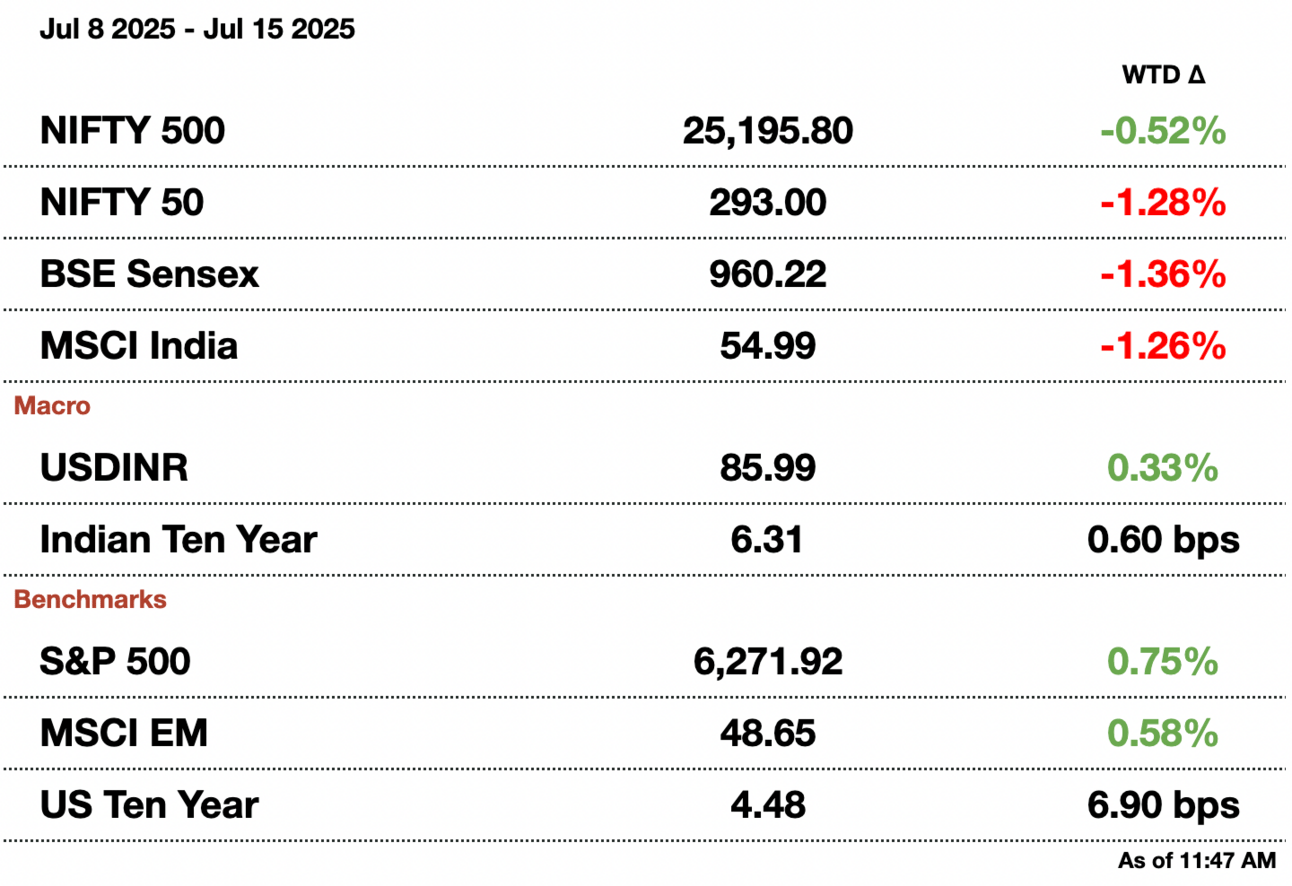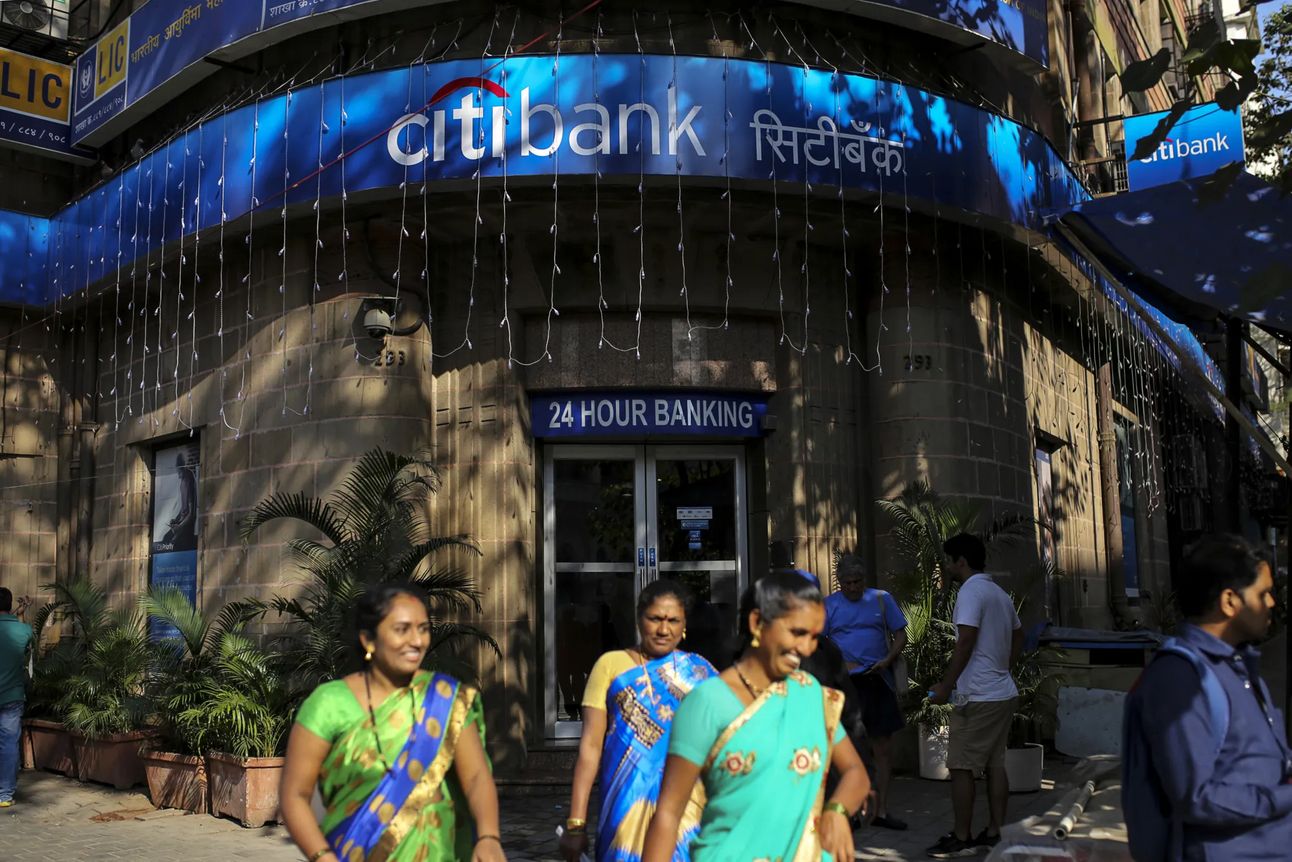- Samosa Capital
- Posts
- 📰When's the next rate cut? | Daily India Briefing
📰When's the next rate cut? | Daily India Briefing
Three stories on Indian markets that you can't miss.


When is the RBI’s next rate cut? Citibank is betting big on Indian IPOs. India’s trade gap narrows to four-month low.
If you have any questions about India, fill out this form or reach out to Shreyas at [email protected]



Macro
India’s jobless rate stayed at 5.6 percent in June, with urban unemployment ticking up to 7.1 percent and youth joblessness rising to 15.3 percent. The labor force participation rate dipped slightly to 54.2 percent due to seasonal farm trends and summer heat.
India’s car sales to dealers fell to an 18-month low in June as weak urban demand and slower wage growth hit discretionary spending, with deliveries dropping 7.4 percent year-on-year. Sales momentum has slowed sharply after record highs in recent years, growing just 2 percent in FY25.
India’s rupee staying in a tight range has revived interest among corporates and banks to sell short-term volatility, betting the currency will remain boxed in near current levels. Traders see stable support and resistance around 86 and 85.20–85.30 per dollar.
Equities
Tesla opened its first showroom in Mumbai, debuting its $70,000 (₹6 million) Model Y as it tests India’s luxury EV market to offset slowing sales elsewhere. The move plants the brand in India, but immediate sales volumes will likely remain modest.
The Executive Centre plans to raise about $300 million (₹25.8 billion) through an IPO in Mumbai to tap India’s growing demand for flexible workspaces. It’s working with Kotak Mahindra Capital and ICICI Securities, joining peers like WeWork India and Awfis in going public.
Indira IVF plans to revive its India IPO to raise about $408 million (₹35.1 billion). Backed by EQT, the deal will be a full exit for some existing shareholders and could be filed later this month.
India’s real estate stocks are rallying on record pre-sales and booming luxury housing demand, boosting investor confidence in a market turnaround. Analysts remain upbeat but caution that aggressive new launches and the risk of oversupply could cool the momentum ahead.
India’s AWL Agri Business (Adani Wilmar) reported a 25 percent drop in quarterly profit as high palm oil prices and muted consumer demand hurt sales. The company expects volumes to rebound as inflation eases and palm oil prices stabilise.
India’s HDB Financial reported a dip in quarterly profit as bad loan provisions surged 63 percent year-on-year, even as overall revenue and loan growth remained steady. Gross bad loans rose to 2.56 percent of total assets by June-end.
India’s ICICI Lombard posted a 29 percent jump in Q1 profit to $87.3 million (₹7.5 billion), boosted by strong growth in retail health and motor insurance premiums, though its combined ratio slightly worsened year-on-year.
India’s Anthem Biosciences’ $395 million (₹33.9 billion) IPO was fully subscribed on day two, as investors bet on the pharma firm’s growth amid global moves to shift drug supply chains from China to India. Shares are expected to debut on July 21.
HDFC Life’s Q1 profit rose 14 percent year-on-year to $63.6 million (₹5.46 billion), boosted by strong demand for group policies and lower claims paid, though growth in market-linked plans slowed amid market volatility.
Alts
Godrej Seeds and Genetics is considering its first rupee bond sale to raise up to $291 million (₹25 billion). The agri-seed firm plans to issue three-to-four-year debt, joining a wave of companies tapping India’s local bond market to secure cheaper funding.
Sumitomo Mitsui is considering investing another $1.1 billion (₹94.5 billion) in Yes Bank, which could raise its total stake to 25 percent. The plan includes buying shares from Carlyle and others, plus $680 million (₹58.4 billion) in convertible bonds, as SMFG bets big on India’s banking growth.
Astronauts from India, Poland, and Hungary completed their countries’ first ISS mission, returning safely with NASA veteran Peggy Whitson aboard a SpaceX capsule. The splashdown off California marked Whitson’s fifth trip to space.
India’s GMR Group plans to raise about $291 million (₹25 billion) through bonds from its airport businesses, with strong demand expected from mutual funds. The issues will offer attractive yields for investors.
Policy
Trump’s threat of penalties on Russia puts India, now its biggest oil buyer, in the spotlight. Since 2022, Russian crude has surged to over a third of India’s oil imports, up from almost none before the Ukraine war. Analysts say India could switch to OPEC suppliers if forced, but at a higher cost, squeezing refiners and pushing up fuel prices at home.
India is in talks with Chile and Peru to secure critical minerals like copper under free trade pacts, aiming to reduce its heavy import dependence and cut reliance on China for key materials.

1. When is the RBI’s next rate cut?

India’s retail inflation has slumped to its lowest level in over six years, fueling expectations for at least one more rate cut this year, but also exposing cracks in domestic demand that could weigh on growth. Headline CPI fell sharply to 2.5 percent in June and is expected to drop further to a record low of 1.1 percent in July, well below the RBI’s 4 percent medium-term target. Even core-core inflation, which strips out volatile items like fuel, remains subdued under 4 percent, signaling softer underlying consumption.
While this disinflation gives the RBI monetary room, it also reflects lackluster urban spending, sluggish wage growth, and depleted household savings. High-frequency indicators highlight the strain: car sales fell to an 18-month low in June and home sales dropped 20 percent in top cities during Q2. Meanwhile, capacity utilization remains stuck near 75 percent, suggesting private investment appetite remains muted despite the RBI’s surprise 50 bps cut last month.
With fiscal policy space constrained by lower tax receipts and a tight budget, monetary easing is now seen as the primary lever to keep India’s growth trajectory near 6–6.5 percent. Several economists expect the central bank to act again in September or October, but persistent supply-side shocks, from food to global trade friction, could complicate the outlook. India’s growth story remains resilient, but sustaining momentum will depend on a revival in consumption and private capex to complement easing inflation.
2. Citibank Betting Big on Indian IPOs

Citibank India is betting big on the next wave of billion-dollar IPOs to anchor its expanding investment banking push, underscoring how India’s maturing capital markets are becoming a core revenue engine for global banks. With a robust pipeline featuring names like Tata Capital, Pine Labs, WeWork India, and LG Electronics India’s unit, the Wall Street giant expects equity capital markets to remain a bright spot in 2025 despite a muted start.
“Capital raising on the equity capital market side remains a big opportunity with a very strong pipeline and quite a few billion-dollar IPOs in that,” said K Balasubramanian, Citibank’s India country head, noting that the bank has grown its local investment banking team by 35 percent in the last year to keep pace with demand. India’s record $20.5 billion (₹1.8 trillion) IPO haul in 2024 has drawn global corporations and maturing startups to the bourse, seeking to unlock value as domestic equity markets deepen and retail inflows hit all-time highs.
Since its exit from retail banking in 2023, Citibank has pivoted to a sharper institutional focus, lifting profit after tax 32 percent last year. New business lines, from securitisation and commercial real estate financing to climate transition funding, are set to complement its IPO pipeline.
For India’s macro story, this speaks to a deepening financial ecosystem: foreign lenders doubling down on capital intermediation, a growing pool of local and global funds ready to back big deals, and fresh momentum for infrastructure and sustainability-linked investments that could underpin India’s next leg of growth.
3. India’s Trade Gap Narrows to Four-Month Low

India’s trade deficit shrank to a four-month low in June, providing some respite for policymakers as the rupee remains under pressure from escalating global tariff tensions. The trade shortfall narrowed to $18.78 billion (₹1.6 trillion), well below economists’ expectations of $21.5 billion (₹1.8 trillion), driven by a 3.7 percent decline in imports to $53.92 billion (₹4.6 trillion) and steady export performance at $35.14 billion (₹3 trillion).
The smaller deficit comes at a critical juncture. With US President Donald Trump threatening higher tariffs on countries he accuses of “anti-American” trade policies, India’s current account dynamics have gained fresh significance. Lower oil and gold imports, down $1 billion (₹85.9 billion) and $700 million (₹60.1 billion) month-on-month, respectively, helped trim the gap, offsetting modest softness in export receipts amid an uneven global demand environment.
A narrower trade gap not only supports the external balance but could also help stabilize the rupee, which has been one of Asia’s laggards this quarter. India recently posted a rare current account surplus for the March quarter, boosting hopes for a more resilient external sector even as tariff risks loom large.
Commerce Secretary Sunil Barthwal pointed to the resilience of India’s exporters despite “the current geopolitical situation.” Meanwhile, trade negotiators are in the US this week to secure an interim deal that could limit tariff hikes and preserve India’s export competitiveness. For policymakers, maintaining this fragile trade balance will be crucial to underpin macro stability and manage currency volatility in the second half of the year.
How would you rate today's daily briefing? |
See you tomorrow.
Written by Eshaan Chanda & Yash Tibrewal. Edited by Shreyas Sinha.
Sponsor the next newsletter to reach tens of thousands of U.S.-based business-savvy professionals. Reach out to [email protected].
Could your business use expert insights to power growth in India? Reach out to [email protected] for a free introductory call.
Disclaimer: This is not financial advice or recommendation for any investment. The Content is for informational purposes only, you should not construe any such information or other material as legal, tax, investment, financial, or other advice.